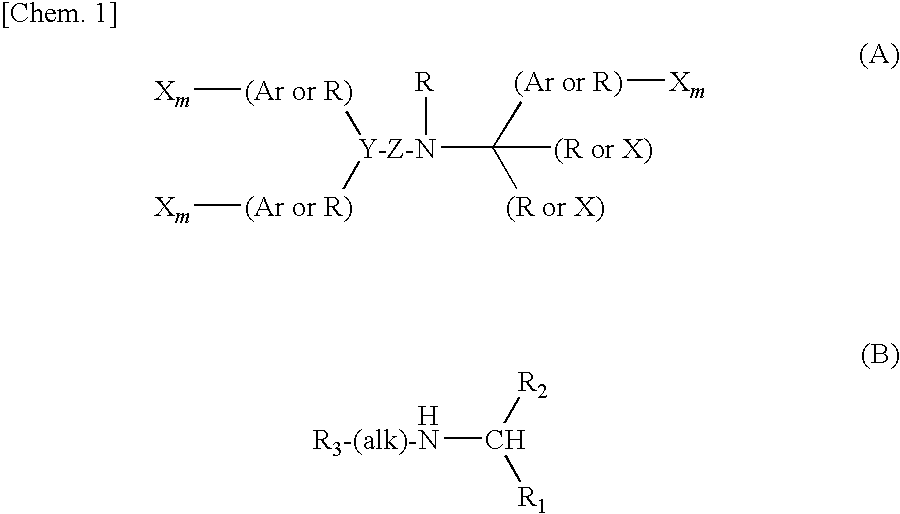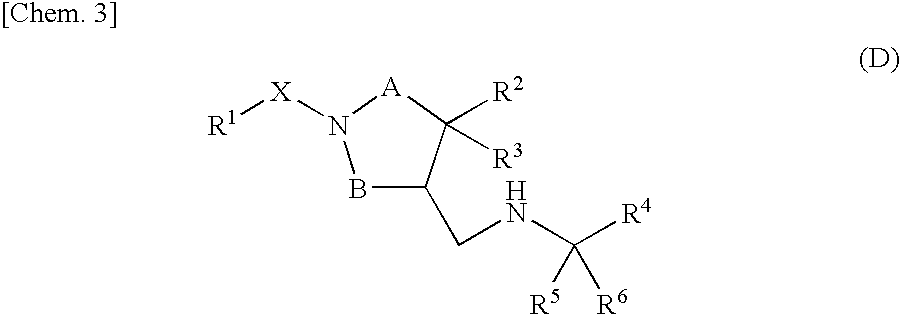Piperidine derivative or salt thereof
a piperidine and derivative technology, applied in the field of medicine, can solve the problems of drug-drug interaction danger, inability to carry out sufficient treatment, and big problem of secondary hyperparathyroidism,
- Summary
- Abstract
- Description
- Claims
- Application Information
AI Technical Summary
Benefits of technology
Problems solved by technology
Method used
Image
Examples
production example 1
[0246]To a mixed solution of 5 g of methyl cyanoacetate, 20 mL of methanol, and 20 mL of toluene was added 1.61 g of sodium hydride (55% oil-dispersion) under ice-cooling. After stirring at room temperature for 30 minutes, to the reaction mixture was added 3.24 mL of methyl cinnamate, followed by stirring at 66° C. for 15 hours. The reaction mixture was cooled to room temperature, and 1 M hydrochloric acid was then added thereto to adjust the pH of the solution to about 7. After extraction with ethyl acetate, the organic layer was dried over anhydrous sodium sulfate. After filtration, the filtrate was concentrated under reduced pressure, and the obtained residue was purified by silica gel column chromatography (hexane-ethyl acetate) to obtain 5.19 g of dimethyl 2-cyano-3-phenylpentanedioate.
production example 2
[0247]To a solution of 22.38 g of methyl acetate in 24.2 mL of toluene was added 11.66 g of sodium methoxide (28 wt % of methanol solution) at room temperature. To the obtained white suspension was added 5.00 g of 2-fluorobenzaldehyde at room temperature. After stirring at room temperature for 2 hours, methyl cyanoacetate and 7.77 g of sodium methoxide (28 wt % of a methanol solution) were further added thereto, followed by stirring at 65° C. overnight. The reaction mixture was cooled to room temperature, and 1 M hydrochloric acid (70 mL) and saturated brine were added thereto in this order, followed by extraction with ethyl acetate. The organic layer was dried over anhydrous sodium sulfate, and after filtration, the filtrate was concentrated under reduced pressure, and the residue was purified by silica gel column chromatography (hexane-ethyl acetate) to obtain 4.66 g of dimethyl 2-cyano-3-(2-fluorophenyl)pentanedioate as a pale yellow oily substance.
production example 3
[0248]To 1.0 L of a solution of 20.0 g of dimethyl 2-cyano-3-phenylpentanedioate and 36.4 g of cobalt chloride (TI) hexahydrate in methanol was added carefully 17.4 g of sodium borohydride under ice-cooling. After stirring at room temperature for 30 minutes, 1 M hydrochloric acid (1.0 L) was added thereto, followed by further stirring at room temperature for 30 minutes. The reaction mixture was concentrated under reduced pressure to a half amount thereof, and then extracted with ethyl acetate. The organic layer was washed with saturated brine, and dried over anhydrous sodium sulfate. After filtration, the filtrate was concentrated under reduced pressure, and the residue was purified by silica gel column chromatography (chloroform-methanol) to obtain 3.84 g of methyl rel-(3R,4S)-6-oxo-4-phenylpiperidine-3-carboxylate as a white solid.
PUM
| Property | Measurement | Unit |
|---|---|---|
| temperature | aaaaa | aaaaa |
| temperature | aaaaa | aaaaa |
| pressure | aaaaa | aaaaa |
Abstract
Description
Claims
Application Information
 Login to View More
Login to View More - R&D
- Intellectual Property
- Life Sciences
- Materials
- Tech Scout
- Unparalleled Data Quality
- Higher Quality Content
- 60% Fewer Hallucinations
Browse by: Latest US Patents, China's latest patents, Technical Efficacy Thesaurus, Application Domain, Technology Topic, Popular Technical Reports.
© 2025 PatSnap. All rights reserved.Legal|Privacy policy|Modern Slavery Act Transparency Statement|Sitemap|About US| Contact US: help@patsnap.com



